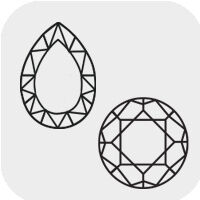Iolite
Meaning and Properties
Iolite History
Iolite is named after the Greek word "ios," meaning violet. The rich purple-y to blue hues of iolite earned this gemstone the nickname of water sapphire. Only officially named in 1912, iolite still was loved and valued by cultures throughout history.
Iolite is sometimes referred to as the Viking's compass. This gemstone is a light polarizer that helped Viking sailors navigate when the sun was hidden by clouds. An iolite lens enabled Vikings to determine the position of the sun even on overcast days, making it possible for them to navigate longer and further than before.
While talismans of iolite were used for centuries, iolite became especially popular for jewelry purposes in Europe during the 18th Century. Iolite is the 21st wedding anniversary stone.

Dig deeper into the chemical makeup, history and metaphysical uses of iolite. See why ancient civilizations treasured this gorgeous color-shifting stone and how you can use it on your own jewelry-making path.
Iolite Metaphysical Properties
It's not surprising, with iolite's ability to help sailors navigate, that the gem became known as the gemstone of clear vision. Iolite was believed to be able to help lost sailors find their way home and was worn by seafaring men. Iolite metaphysical beliefs suggest the gemstone can guide the lost home as well as the ability to open spiritual pathways that connect the living with the dead. Iolite has been used by shamans to enhance their ability to have clear visions. Some legends even say iolite strengthens eyesight. Other metaphysical beliefs hold that iolite promotes pure thoughts, intuition and self-acceptance. Iolite is associated with the zodiac signs Libra, Sagittarius and Taurus.
Iolite Geological Properties
Iolite is the gemstone variety of cordierite, a magnesium iron aluminum cyclosilicate mineral named after the French geologist Cordier. As with some other blue gemstones, iolite is known for its pleochroic properties. Pleochroism is an optical phenomenon where the gemstone appears to be different colors depending on the angle and light source. Polarized light especially displays iolite's pleochroism. Ranging from deep blue to a purple tint, the deeper the color the more valuable the iolite gem is said to be. Most of today's iolite comes from India, Australia, Brazil, Canada, Madagascar, Myanmar, Namibia, Sri Lanka, Tanzania and the United States.
|
|
|
|
|
|
|
|
|
|
|
|
|
|
|
|
|
|
Proper Care of Iolite
Though iolite is fairly hard with a Mohs hardness of 7 to 7-1/2, it is still wise to be gentle with this pleochroic gemstone. Iolite is susceptible to damage caused by heat and temperature changes, so it is not recommended to use boiling, ultrasonic or steam cleaning methods. The best method to clean iolite is so rinse with warm water and mild dish soap. Detergents, bleaches and other harsh cleaning chemicals are not suggested. Use a soft brush to remove remnants of makeup or other grime and gently, but thoroughly, pat dry before wearing or storing. It is a good idea to put on your jewelry, including iolite jewelry, after applying cosmetic products such as hairspray and perfume.
To learn more about iolite and other gemstones, order your copy of Walter Schumann's revised and expanded edition of Gemstones of the World.
Designing with Iolite
Iolite is considered a suitable substitute for more expensive blue gemstones such as sapphires to create regal jewelry without a royal price tag. Create monochrome jewelry designs using iolite alongside other blueish to purple gems such as tanzanite. Greens, yellows and oranges are complimentary to blue and purple tones on the color wheel, creating a dynamic color difference when used together in jewelry.
Pale varieties of iolite look less washed out when paired with other gently colored gemstones while more saturated specimens loose no brilliance when used with other bright gems such as topaz, ruby and emerald. Since this gemstone rose to such popularity in 18th Century England, jewelry that emulates those of the Georgian era is especially fitting for iolite.
View more resources featuring iolite, including Design Ideas, Videos, Tutorials and more!
Shop for Iolite
**Please note that all metaphysical or healing properties listed are collected from various sources. This information is offered as a service and not meant to treat medical conditions. Fire Mountain Gems and Beads® does not guarantee the validity of any of these statements.
How did you like this resource? Your feedback helps us provide resources that matter to you most.
Copyright Permissions
All works of authorship (articles, videos, tutorials and other creative works) are from the Fire Mountain Gems and Beads® Collection, and permission to copy is granted for non-commercial educational purposes only. All other reproduction requires written permission. For more information, please email copyrightpermission@firemtn.com.



